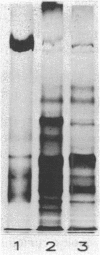Abstract
Mutants of Salmonella typhimurium that lack the biosynthetic sulfite reductase (cysI and cysJ mutants) retain the ability to reduce sulfite for growth under anaerobic conditions (E. L. Barrett and G. W. Chang, J. Gen. Microbiol., 115:513-516, 1979). Here we report studies of sulfite reduction by a cysI mutant of S. typhimurium and purification of the associated anaerobic sulfite reductase. Sulfite reduction for anaerobic growth did not require a reducing atmosphere but was prevented by an argon atmosphere contaminated with air (less than 0.33%). It was also prevented by the presence of 0.1 mM nitrate, which argues against a strictly biosynthetic role for anaerobic sulfite reduction. Anaerobic growth in liquid minimal medium, but not on agar, was found to require additions of trace amounts (10(-7)M) of cysteine. Spontaneous mutants that grew under the argon contaminated with air also lost the requirement for 10(-7)M cysteine for anaerobic growth in liquid. A role for sulfite reduction in anaerobic energy generation was contraindicated by the findings that sulfite reduction did not improve cell yields, and anaerobic sulfite reductase activity was greatest during the stationary phase of growth. Sulfite reductase was purified from the cytoplasmic fraction of the anaerobically grown cysI mutant and was purified 190-fold. The most effective donor in crude extracts was NADH. NADPH and methyl viologen were, respectively, 40 and 30% as effective as NADH. Oxygen reversibly inhibited the enzyme. Two high-molecular-weight proteins separated by gel filtration (Mr 360,000 and 490,000, respectively) were required for maximal activity with NADH. Indirect evidence, including in vitro complementation experiments with a cysG mutant extract, suggested that the 360,000-Mr component contains siroheme and is the terminal reductase. This component was further purified to near homogeneity and was found to consist of a single subunit of molecular weight 67,500. The anaerobic sulfite reductase showed some resemblance to the biosynthetic sulfite reductase, but apparently it has a unique, as yet unidentified function.
Full text
PDF
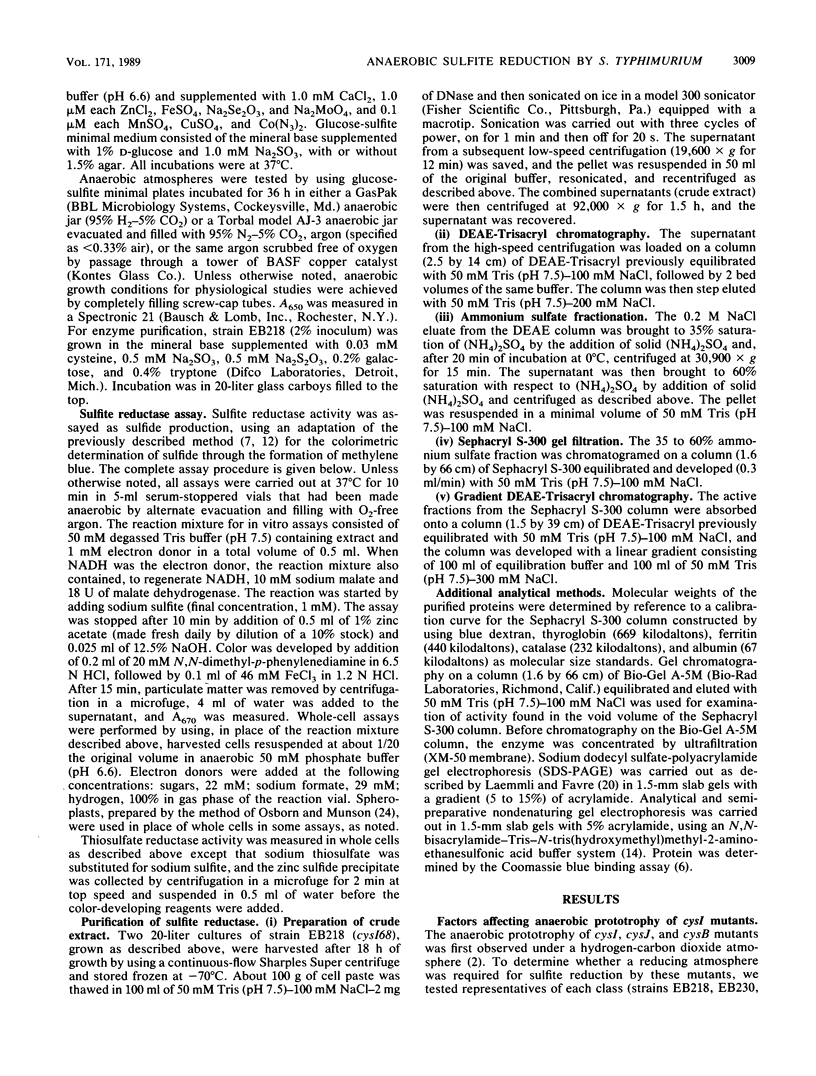
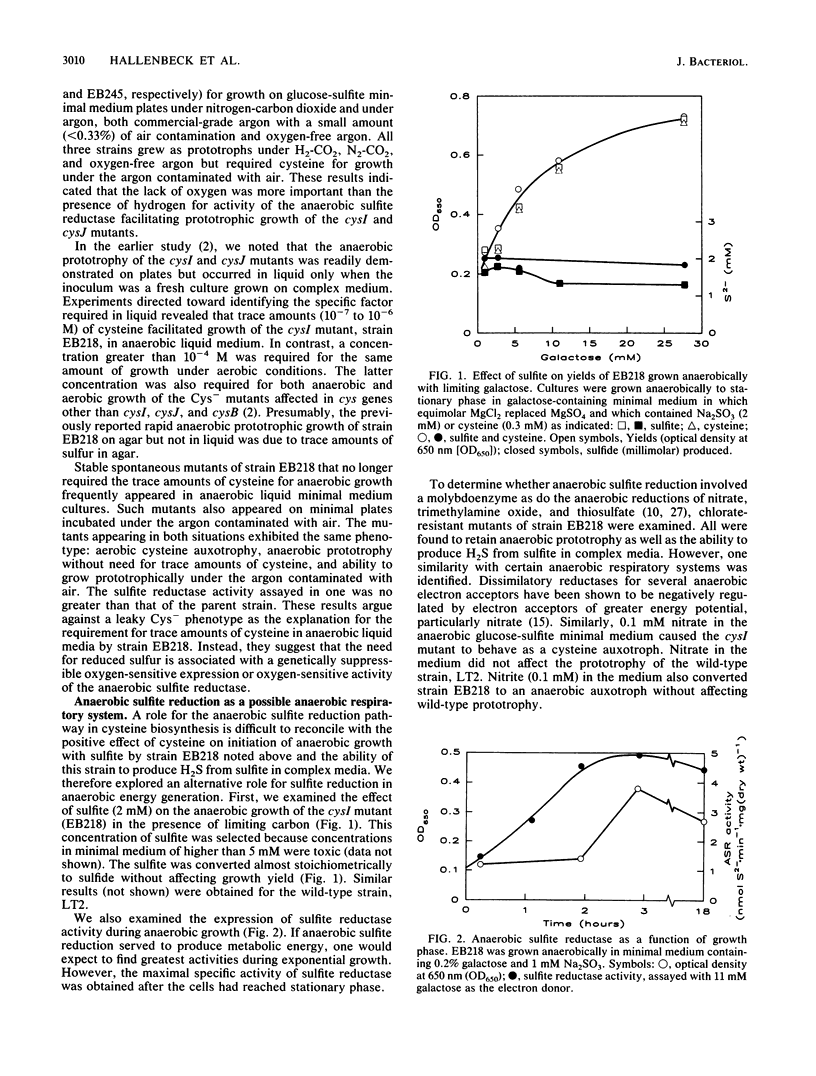
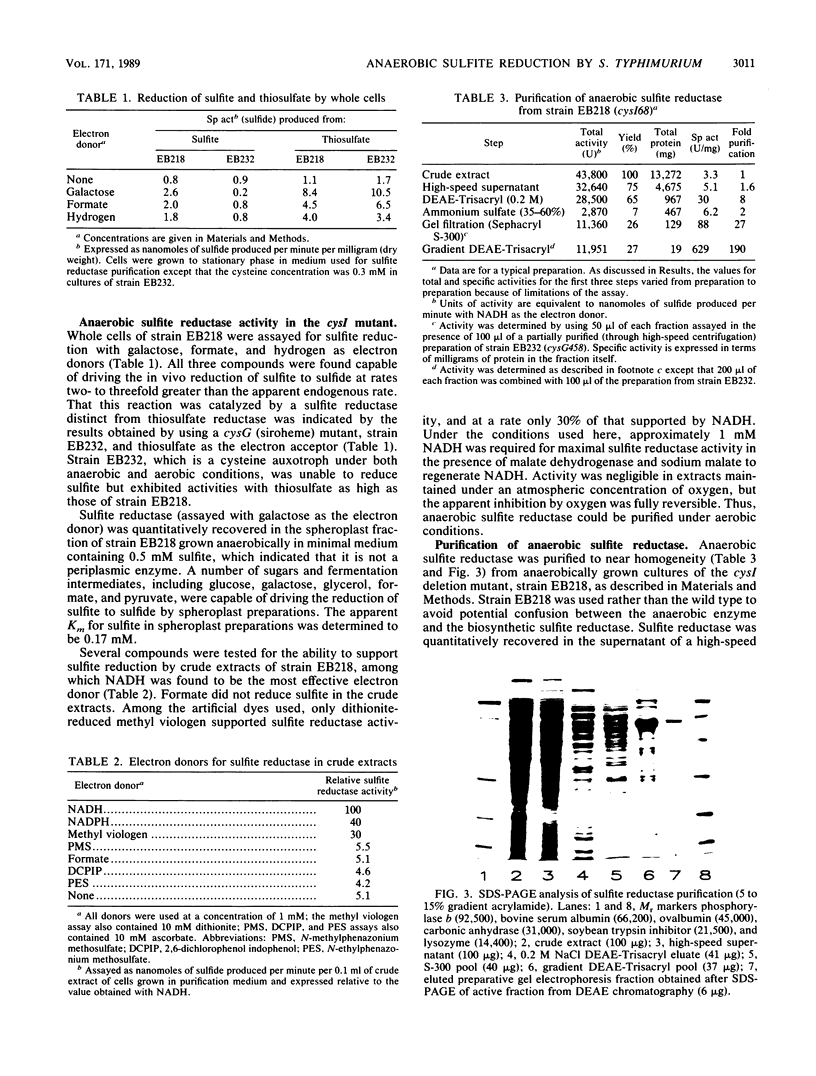
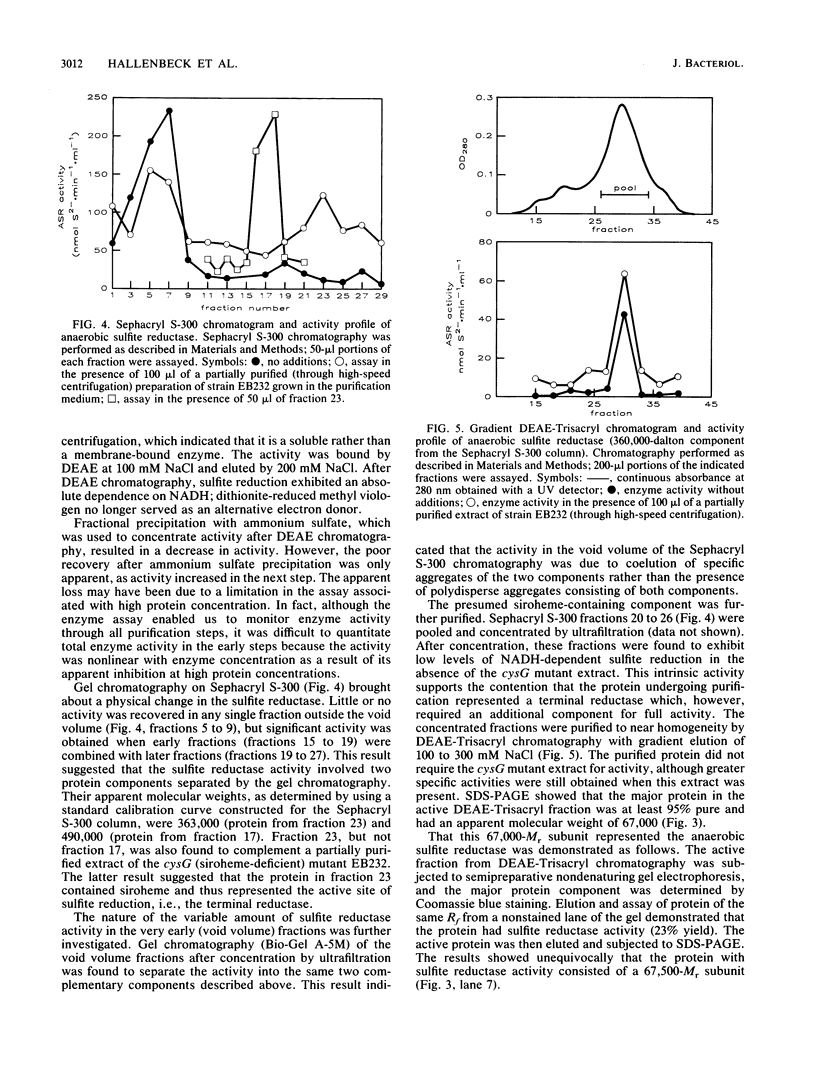
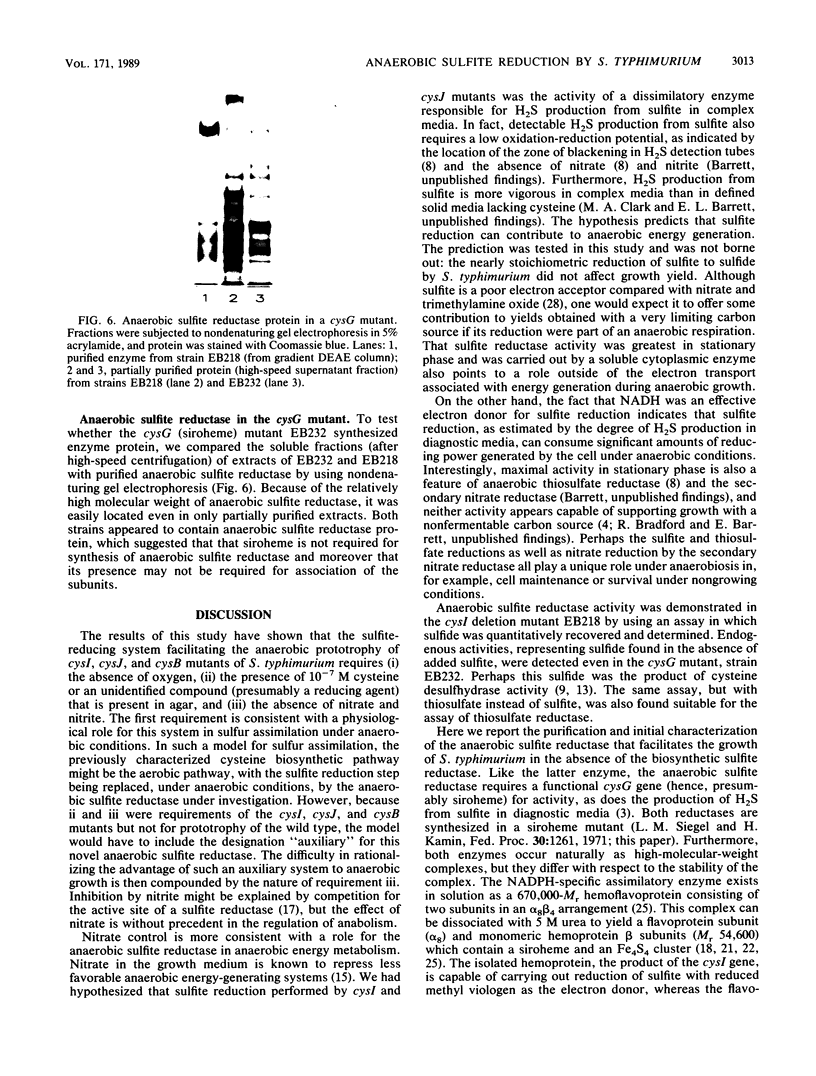

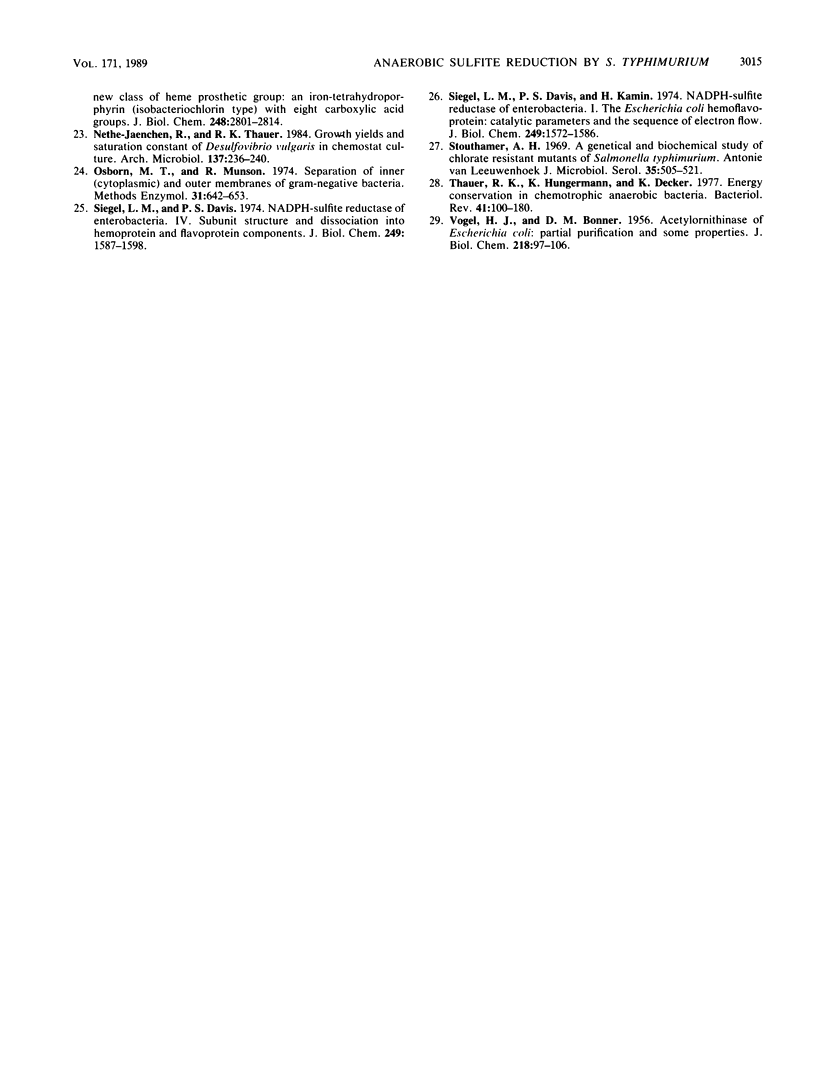
Images in this article
Selected References
These references are in PubMed. This may not be the complete list of references from this article.
- Badziong W., Thauer R. K. Growth yields and growth rates of Desulfovibrio vulgaris (Marburg) growing on hydrogen plus sulfate and hydrogen plus thiosulfate as the sole energy sources. Arch Microbiol. 1978 May 30;117(2):209–214. doi: 10.1007/BF00402310. [DOI] [PubMed] [Google Scholar]
- Barrett E. L., Chang G. W. Cysteine auxotrophs of Salmonella typhimurium which grow without cysteine in a hydrogen/carbon dioxide atmosphere. J Gen Microbiol. 1979 Dec;115(2):513–516. doi: 10.1099/00221287-115-2-513. [DOI] [PubMed] [Google Scholar]
- Barrett E. L., Clark M. A. Tetrathionate reduction and production of hydrogen sulfide from thiosulfate. Microbiol Rev. 1987 Jun;51(2):192–205. doi: 10.1128/mr.51.2.192-205.1987. [DOI] [PMC free article] [PubMed] [Google Scholar]
- Barrett E. L., Riggs D. L. Evidence of a second nitrate reductase activity that is distinct from the respiratory enzyme in Salmonella typhimurium. J Bacteriol. 1982 May;150(2):563–571. doi: 10.1128/jb.150.2.563-571.1982. [DOI] [PMC free article] [PubMed] [Google Scholar]
- Borum P. R., Monty K. J. Regulatory mutants and control of cysteine biosynthetic enzymes in Salmonella typhimurium. J Bacteriol. 1976 Jan;125(1):94–101. doi: 10.1128/jb.125.1.94-101.1976. [DOI] [PMC free article] [PubMed] [Google Scholar]
- Bradford M. M. A rapid and sensitive method for the quantitation of microgram quantities of protein utilizing the principle of protein-dye binding. Anal Biochem. 1976 May 7;72:248–254. doi: 10.1016/0003-2697(76)90527-3. [DOI] [PubMed] [Google Scholar]
- Chen J. S., Mortenson L. E. Inhibition of methylene blue formation during determination of the acid-labile sulfide of iron-sulfur protein samples containing dithionite. Anal Biochem. 1977 May 1;79(1-2):157–165. doi: 10.1016/0003-2697(77)90390-6. [DOI] [PubMed] [Google Scholar]
- Clark M. A., Barrett E. L. The phs gene and hydrogen sulfide production by Salmonella typhimurium. J Bacteriol. 1987 Jun;169(6):2391–2397. doi: 10.1128/jb.169.6.2391-2397.1987. [DOI] [PMC free article] [PubMed] [Google Scholar]
- Collins J. M., Wallenstein A., Monty K. J. Regulatory features of the cysteine desulfhydrase of Salmonella typhimurium. Biochim Biophys Acta. 1973 Jun 20;313(1):156–162. doi: 10.1016/0304-4165(73)90196-7. [DOI] [PubMed] [Google Scholar]
- Faeder E. J., Davis P. S., Siegel L. M. Reduced nicotinamide adenine dinucleotide phosphate-sulfite reductase of enterobacteria. V. Studies with the Escherichia coli hemoflavoprotein depleted of flavin mononucleotide: distinct roles for the flavin adenine dinucleotide and flavin mononucleotide prosthetic groups in catalysis. J Biol Chem. 1974 Mar 10;249(5):1599–1609. [PubMed] [Google Scholar]
- Guarneros G., Ortega M. V. Cysteine desulfhydrase activities of Salmonella typhimurium and Escherichia coli. Biochim Biophys Acta. 1970 Jan 14;198(1):132–142. doi: 10.1016/0005-2744(70)90041-0. [DOI] [PubMed] [Google Scholar]
- Hallenbeck P. C., Vimr E. R., Yu F., Bassler B., Troy F. A. Purification and properties of a bacteriophage-induced endo-N-acetylneuraminidase specific for poly-alpha-2,8-sialosyl carbohydrate units. J Biol Chem. 1987 Mar 15;262(8):3553–3561. [PubMed] [Google Scholar]
- Iuchi S., Lin E. C. The narL gene product activates the nitrate reductase operon and represses the fumarate reductase and trimethylamine N-oxide reductase operons in Escherichia coli. Proc Natl Acad Sci U S A. 1987 Jun;84(11):3901–3905. doi: 10.1073/pnas.84.11.3901. [DOI] [PMC free article] [PubMed] [Google Scholar]
- Jagura G., Hulanicka D. Analysis of merodiploids of the cysB region in Salmonella typhimurium. Mol Gen Genet. 1978 Sep 20;165(1):31–38. doi: 10.1007/BF00270373. [DOI] [PubMed] [Google Scholar]
- Janick P. A., Rueger D. C., Krueger R. J., Barber M. J., Siegel L. M. Characterization of complexes between Escherichia coli sulfite reductase hemoprotein subunit and its substrates sulfite and nitrite. Biochemistry. 1983 Jan 18;22(2):396–408. doi: 10.1021/bi00271a025. [DOI] [PubMed] [Google Scholar]
- Janick P. A., Siegel L. M. Electron paramagnetic resonance and optical spectroscopic evidence for interaction between siroheme and Fe4S4 prosthetic groups in Escherichia coli sulfite reductase hemoprotein subunit. Biochemistry. 1982 Jul 20;21(15):3538–3547. doi: 10.1021/bi00258a003. [DOI] [PubMed] [Google Scholar]
- Laemmli U. K., Favre M. Maturation of the head of bacteriophage T4. I. DNA packaging events. J Mol Biol. 1973 Nov 15;80(4):575–599. doi: 10.1016/0022-2836(73)90198-8. [DOI] [PubMed] [Google Scholar]
- McRee D. E., Richardson D. C., Richardson J. S., Siegel L. M. The heme and Fe4S4 cluster in the crystallographic structure of Escherichia coli sulfite reductase. J Biol Chem. 1986 Aug 5;261(22):10277–10281. [PubMed] [Google Scholar]
- Murphy M. J., Siegel L. M., Kamin H., Rosenthal D. Reduced nicotinamide adenine dinucleotide phosphate-sulfite reductase of enterobacteria. II. Identification of a new class of heme prosthetic group: an iron-tetrahydroporphyrin (isobacteriochlorin type) with eight carboxylic acid groups. J Biol Chem. 1973 Apr 25;248(8):2801–2814. [PubMed] [Google Scholar]
- Osborn M. J., Munson R. Separation of the inner (cytoplasmic) and outer membranes of Gram-negative bacteria. Methods Enzymol. 1974;31:642–653. doi: 10.1016/0076-6879(74)31070-1. [DOI] [PubMed] [Google Scholar]
- Siegel L. M., Davis P. S., Kamin H. Reduced nicotinamide adenine dinucleotide phosphate-sulfite reductase of enterobacteria. 3. The Escherichia coli hemoflavoprotein: catalytic parameters and the sequence of electron flow. J Biol Chem. 1974 Mar 10;249(5):1572–1586. [PubMed] [Google Scholar]
- Siegel L. M., Davis P. S. Reduced nicotinamide adenine dinucleotide phosphate-sulfite reductase of enterobacteria. IV. The Escherichia coli hemoflavoprotein: subunit structure and dissociation into hemoprotein and flavoprotein components. J Biol Chem. 1974 Mar 10;249(5):1587–1598. [PubMed] [Google Scholar]
- Stouthamer A. H. A genetical and biochemical study of chlorate-resistant mutants of Salmonella typhimurium. Antonie Van Leeuwenhoek. 1969;35(4):505–521. doi: 10.1007/BF02219168. [DOI] [PubMed] [Google Scholar]
- Thauer R. K., Jungermann K., Decker K. Energy conservation in chemotrophic anaerobic bacteria. Bacteriol Rev. 1977 Mar;41(1):100–180. doi: 10.1128/br.41.1.100-180.1977. [DOI] [PMC free article] [PubMed] [Google Scholar]
- VOGEL H. J., BONNER D. M. Acetylornithinase of Escherichia coli: partial purification and some properties. J Biol Chem. 1956 Jan;218(1):97–106. [PubMed] [Google Scholar]




